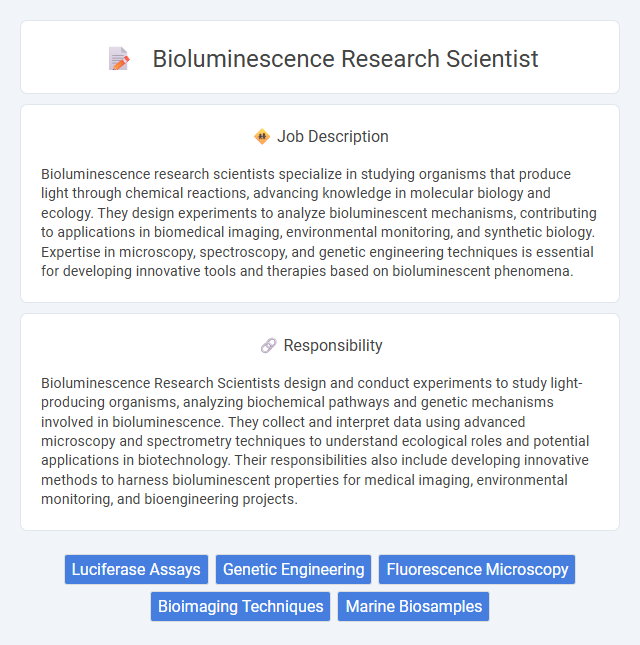
Bioluminescence research scientists specialize in studying organisms that produce light through chemical reactions, advancing knowledge in molecular biology and ecology. They design experiments to analyze bioluminescent mechanisms, contributing to applications in biomedical imaging, environmental monitoring, and synthetic biology. Expertise in microscopy, spectroscopy, and genetic engineering techniques is essential for developing innovative tools and therapies based on bioluminescent phenomena.
People with a strong curiosity about marine biology or chemical processes may find the Bioluminescence Research Scientist role highly suitable. Individuals who enjoy meticulous laboratory work and data analysis likely have the necessary skills to thrive in this specialized field. Those who prefer dynamic team environments and can handle extended periods of concentration may have a higher probability of success in this career.
Qualification
A Bioluminescence Research Scientist must hold a PhD in Molecular Biology, Biochemistry, or a related field, with extensive experience in bioluminescent protein analysis and imaging techniques. Proficiency in advanced microscopy, gene cloning, and protein engineering is essential for experimental design and data interpretation. Strong analytical skills, familiarity with bioinformatics tools, and a background in fluorescence spectroscopy further enhance the ability to develop innovative bioluminescent assays.
Responsibility
Bioluminescence Research Scientists design and conduct experiments to study light-producing organisms, analyzing biochemical pathways and genetic mechanisms involved in bioluminescence. They collect and interpret data using advanced microscopy and spectrometry techniques to understand ecological roles and potential applications in biotechnology. Their responsibilities also include developing innovative methods to harness bioluminescent properties for medical imaging, environmental monitoring, and bioengineering projects.
Benefit
Bioluminescence research scientists likely enjoy the benefit of contributing to groundbreaking discoveries in natural light-emitting organisms, which may advance medical imaging and environmental monitoring. They probably gain access to cutting-edge laboratory technologies and collaborate with interdisciplinary teams, enhancing their expertise and career growth. Financial rewards and opportunities for publication in prestigious scientific journals might also be common benefits of this specialized role.
Challenge
A Bioluminescence Research Scientist likely faces the challenge of isolating and studying light-producing biological compounds in varied and often delicate environmental conditions. There is probable complexity in developing innovative methods to capture and measure faint bioluminescent signals for accurate data analysis. Navigating interdisciplinary collaboration while keeping pace with rapidly evolving technologies may also present ongoing obstacles.
Career Advancement
Bioluminescence research scientists explore the molecular mechanisms and genetic pathways of natural light production in organisms, contributing to innovations in medical diagnostics and environmental monitoring. Career advancement typically involves progressing from laboratory technician roles to lead researcher or project manager positions, with opportunities to specialize in bioengineering or synthetic biology. Gaining expertise in advanced imaging techniques and securing research grants enhances prospects for tenure-track faculty roles or leadership in biotech companies.
Key Terms
Luciferase Assays
Bioluminescence Research Scientists specializing in luciferase assays develop and optimize experimental protocols to measure gene expression, cellular events, and biochemical activities using luciferase reporter systems. Their expertise includes engineering luciferase enzyme variants for increased sensitivity and implementing high-throughput screening methods to analyze biological processes in drug discovery and molecular biology. Mastery of data analysis software and instrumentation for luminescence detection is essential to accurately quantify light emission and interpret experimental outcomes.
Genetic Engineering
Bioluminescence research scientists specializing in genetic engineering manipulate genes to enhance or introduce light-producing traits in organisms, advancing applications in medical imaging, environmental monitoring, and biotechnology. They employ CRISPR, synthetic biology, and molecular cloning techniques to modify luminescent pathways in bacteria, algae, and animals. These scientists collaborate with interdisciplinary teams to design bioluminescent markers, improving detection sensitivity for disease diagnostics and ecological studies.
Fluorescence Microscopy
Bioluminescence Research Scientists specialize in using fluorescence microscopy to study cellular and molecular processes involving light-emitting organisms. They employ advanced imaging techniques to visualize bioluminescent proteins and their interactions within live cells, enabling insights into gene expression, protein localization, and cellular dynamics. Expertise in fluorescence lifetime imaging microscopy (FLIM) and confocal microscopy is essential to enhance the resolution and accuracy of bioluminescent signal detection.
Bioimaging Techniques
Bioluminescence Research Scientists specialize in developing and applying advanced bioimaging techniques to study cellular and molecular processes in living organisms. Expertise in luminescent protein markers, such as luciferase, enables precise visualization of dynamic biological events with high sensitivity and minimal phototoxicity. Their work supports breakthroughs in drug discovery, disease diagnostics, and real-time monitoring of gene expression.
Marine Biosamples
A Bioluminescence Research Scientist specializing in marine biosamples conducts advanced studies on light-emitting marine organisms such as dinoflagellates, jellyfish, and deep-sea fish. This role involves collecting, analyzing, and experimenting with marine biosamples to understand biochemical pathways, genetic expressions, and ecological impacts of bioluminescence. Expertise in molecular biology techniques, fluorescence imaging, and environmental data analysis is essential for breakthroughs in applications ranging from biomedical imaging to environmental monitoring.
 kuljobs.com
kuljobs.com